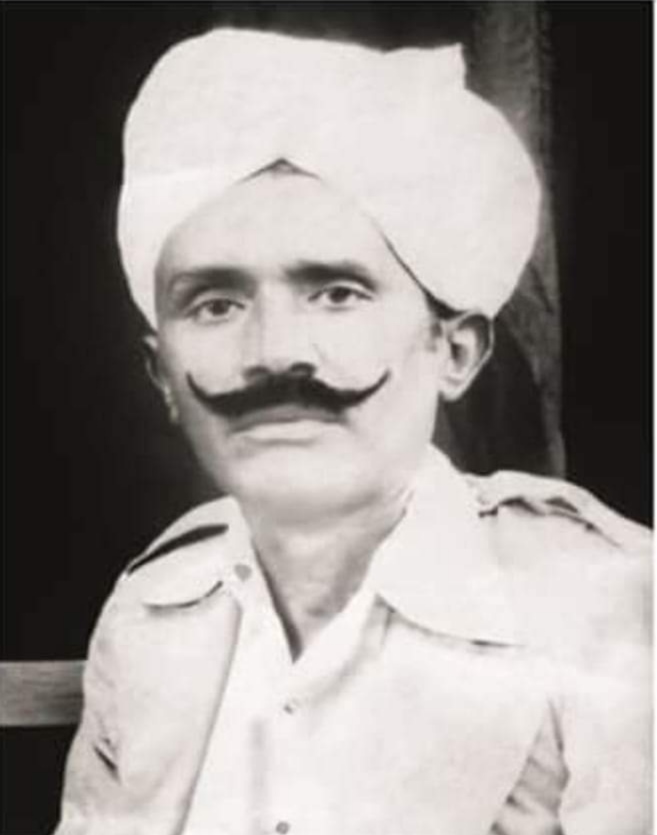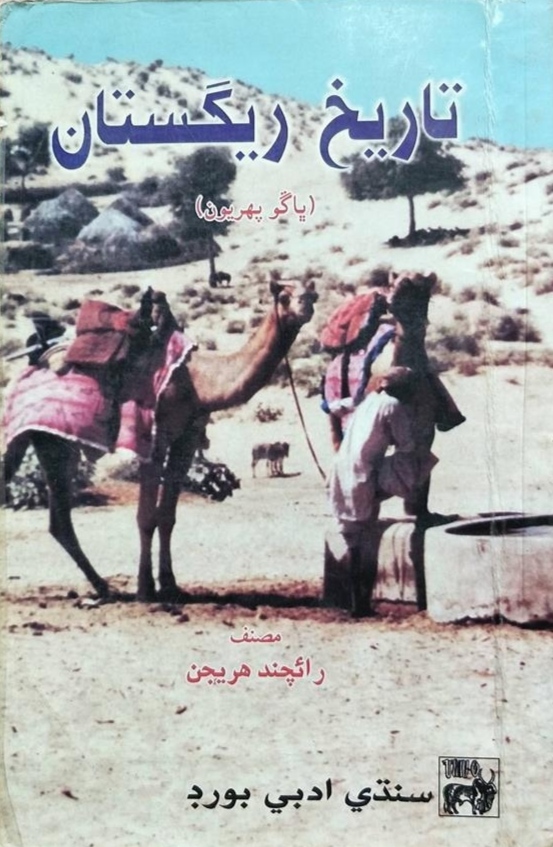
Ustad Raichand’s book ‘Tareekh-e-Registan’ (2 Volumes) is a comprehensive document on history of Thar
By Noor Ahmed Janjhi
History and historiography have great importance in human history. It is an attempt to maintain counting the succession of time not only to document the past but relate the same with present. Thus it is the documentation of past events that analyses the relationship between cause and effect. Being a fundamental discipline it has evolved and reached to the systematic discipline of historiography. The history of Thar has emerged from the verbal heritage and folklore as of the histories of other parts of world. British officials documented some segments of information in their official reports and the reports also became the source material of historiography of the area.
 The documentation of the place and people and the historic and cultural events of Thar had been done by different historians in different languages. But it was not so comprehensive history documentation available till Tareekh-e-Registan was written by Ustad Raichand. Ustad Raichand (b. 8.11.1912, d 31.5.1968) was a primary teacher belonging to a poor community. Despite his limitations he was greatly inspired by the history and great historians of world. He studied a great deal of books on the subject in Sindhi, Urdu, Gujarati, Arabic, Persian and English languages. He developed his concept about the history writing of Thar from the excavation and documentation of the other areas of Sindh. He has mentioned it in the preface of the volume two of his book. The first volume of the book…Tareekh Registan consists of some two hundred and seventy eight pages full of basic information in seventeen chapters. The preface of it reads the date 1, November 1953 and its first edition was brought out by Sindhi Adabi Board in 1956. His vision about the history and historiography reflects from the intro of the preface. He writes, “It is necessary for every nation to study history and culture. The nation does not have information of its foregone people and the country, the nation and the country cannot develop at all. According to an English maxim, “If you want to kill any nation, kill its history and the nation will be perished away automatically.” It was his consciousness about the historiography that spurred him to write on his people and dear motherland. He was not motivated by any of project assignment like other great names of the field. He was committed and devoted person who not only documented the history and the antiquity of the area but also offered a good deal of information on culture. As he went through the work on the other areas of Sindh, he started work on the history of Tharparkar. He referred all of the basic source material on the subject. He has mentioned Raikes (The Memoir on Thurr and Parkur 1859), Advani ( Sodhan ji Sahibi 1924), Solanki (Amarkot Sindh jo Itehas 1934) and Ursani (Badnaseeb Thari and Sair e Registan ).He mentions the report of Raikes (The Memoir was written in 1856 and published in 1896) as the first document on the subject. However, Col James Tod was the first British official to document a detailed account of Rajasthan in his report Annals and Antiquities of Rajasthan in two volumes (published in 1829, 1832) with a special chapter on the desert area. Molvi Najmul Ghani has written a rejoinder to the Tod’s book under the title of Tareekh Rajagan e Hind known as Waqaia e Rajasthan.
The documentation of the place and people and the historic and cultural events of Thar had been done by different historians in different languages. But it was not so comprehensive history documentation available till Tareekh-e-Registan was written by Ustad Raichand. Ustad Raichand (b. 8.11.1912, d 31.5.1968) was a primary teacher belonging to a poor community. Despite his limitations he was greatly inspired by the history and great historians of world. He studied a great deal of books on the subject in Sindhi, Urdu, Gujarati, Arabic, Persian and English languages. He developed his concept about the history writing of Thar from the excavation and documentation of the other areas of Sindh. He has mentioned it in the preface of the volume two of his book. The first volume of the book…Tareekh Registan consists of some two hundred and seventy eight pages full of basic information in seventeen chapters. The preface of it reads the date 1, November 1953 and its first edition was brought out by Sindhi Adabi Board in 1956. His vision about the history and historiography reflects from the intro of the preface. He writes, “It is necessary for every nation to study history and culture. The nation does not have information of its foregone people and the country, the nation and the country cannot develop at all. According to an English maxim, “If you want to kill any nation, kill its history and the nation will be perished away automatically.” It was his consciousness about the historiography that spurred him to write on his people and dear motherland. He was not motivated by any of project assignment like other great names of the field. He was committed and devoted person who not only documented the history and the antiquity of the area but also offered a good deal of information on culture. As he went through the work on the other areas of Sindh, he started work on the history of Tharparkar. He referred all of the basic source material on the subject. He has mentioned Raikes (The Memoir on Thurr and Parkur 1859), Advani ( Sodhan ji Sahibi 1924), Solanki (Amarkot Sindh jo Itehas 1934) and Ursani (Badnaseeb Thari and Sair e Registan ).He mentions the report of Raikes (The Memoir was written in 1856 and published in 1896) as the first document on the subject. However, Col James Tod was the first British official to document a detailed account of Rajasthan in his report Annals and Antiquities of Rajasthan in two volumes (published in 1829, 1832) with a special chapter on the desert area. Molvi Najmul Ghani has written a rejoinder to the Tod’s book under the title of Tareekh Rajagan e Hind known as Waqaia e Rajasthan.
 Ustad Raichand, being a primary teacher and having scanty of resources, faced many hindrances and difficulties in this work. Many people discouraged him and advised to leave the idea of an uphill task. In spite of all the obstacles he continued his pursuit. He was encouraged by Muhammad Ismail Ursani, Dr. Nabi Bakhsh Baloch, Prof Mahboob Ali Channa and Mir Muhammad Bakhsh Talpur. He has given a large list of books he had referred during the documentation of his great book. After publishing of the first volume, he thinks to elaborate the history in detail and includes the topics of culture. He mentions a great point in the preface of the second volume about the history that the documentation of most of the history books seems to be the history of have classes and the idea inspired him to jot it down the detailed account of the culture of the area. It was his attempt towards documentation the history of have-nots or marginalized classes. He was of the opinion that history must not be the account of only rulers but it should include the account of poor people. He has focused on the importance of simple language and geography in historiography. The second volume of Tareekh Registan containing 504 pages and 22 chapters was published firstly in 1975.
Ustad Raichand, being a primary teacher and having scanty of resources, faced many hindrances and difficulties in this work. Many people discouraged him and advised to leave the idea of an uphill task. In spite of all the obstacles he continued his pursuit. He was encouraged by Muhammad Ismail Ursani, Dr. Nabi Bakhsh Baloch, Prof Mahboob Ali Channa and Mir Muhammad Bakhsh Talpur. He has given a large list of books he had referred during the documentation of his great book. After publishing of the first volume, he thinks to elaborate the history in detail and includes the topics of culture. He mentions a great point in the preface of the second volume about the history that the documentation of most of the history books seems to be the history of have classes and the idea inspired him to jot it down the detailed account of the culture of the area. It was his attempt towards documentation the history of have-nots or marginalized classes. He was of the opinion that history must not be the account of only rulers but it should include the account of poor people. He has focused on the importance of simple language and geography in historiography. The second volume of Tareekh Registan containing 504 pages and 22 chapters was published firstly in 1975.
Although he has done a great and painstaking work on the history and historiography of Tharparkar yet he seems very humble in his approach and expects much more work on the subject. Besides the history, he has good documentation of folklore especially folksongs too. He left a great example of dedication and commitment in the field of history and historiography.
Besides the history of Tharparkar, Ustad Raichand has written on folk and culture of Thar too. His work is worth studying and researched further.
________________
About the Author
 Noor Ahmed Janjhi is a senior educationist based in Desert District Tharparkar Sindh. He is author of several books in Sindhi as well as English language on folk literature including two poetry books.
Noor Ahmed Janjhi is a senior educationist based in Desert District Tharparkar Sindh. He is author of several books in Sindhi as well as English language on folk literature including two poetry books.